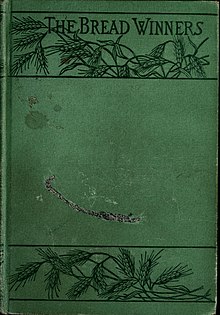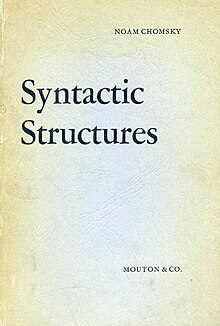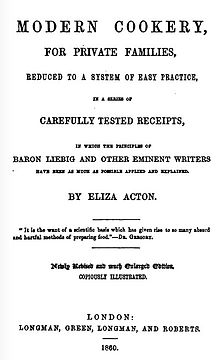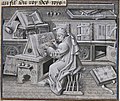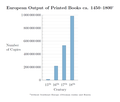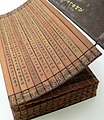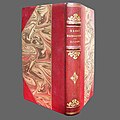Portal:Books
The Books Portal
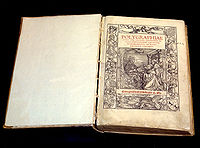
A book is a medium for recording information in the form of writing or images. Books are typically composed of many pages, bound together and protected by a cover. Modern bound books were preceded by many other written mediums, such as the codex and the scroll. The book publishing process is the series of steps involved in their creation and dissemination.
As a conceptual object, a book typically refers to a written work of substantial length, which may be distributed either physically or in digital forms like ebooks. These works are broadly classified into fiction (containing imaginary content) and non-fiction (containing content representing truths). Many smaller categories exist within these, such as children's literature meant to match the reading level and interests of children, or reference works that gather collections of non-fiction. Books are traded at both regular stores and specialized bookstores, and people can borrow them from libraries. The reception of books has led to a number of social consequences, including censorship.
A physical book does not need to contain written works: for example, it may contain only drawings, engravings, photographs, puzzles, or removable content like paper dolls. Physical books may be left empty to be used for writing or drawing, such as account books, appointment books, autograph books, notebooks, diaries and sketchbooks.
The contemporary book industry has seen several major changes due to new technologies. In some markets, the sale of printed books has decreased due to the increased use of eBooks. However, printed books still largely outsell eBooks, and many people have a preference for print. The 21st century has also seen a rapid rise in the popularity of audiobooks, which are recordings of books being read aloud. Additionally, awareness of the needs of people who can't access print media due to limitations like visual impairment has led to a rise in formats designed for greater accessibility, such as braille printing or formats supporting text-to-voice. Google Books estimated that as of 2010, approximately 130,000,000 unique books had been published. (Full article...)
Featured articles -
-
Fertilisation of Orchids is a book by English naturalist Charles Darwin published on 15 May 1862 under the full explanatory title On the Various Contrivances by Which British and Foreign Orchids Are Fertilised by Insects, and On the Good Effects of Intercrossing. Darwin's previous book, On the Origin of Species, had briefly mentioned evolutionary interactions between insects and the plants they fertilised, and this new idea was explored in detail. Field studies and practical scientific investigations that were initially a recreation for Darwin—a relief from the drudgery of writing—developed into enjoyable and challenging experiments. Aided in his work by his family, friends, and a wide circle of correspondents across Britain and worldwide, Darwin tapped into the contemporary vogue for growing exotic orchids.
The book was his first detailed demonstration of the power of natural selection, and explained how complex ecological relationships resulted in the coevolution of orchids and insects. The view has been expressed that the book led directly or indirectly to all modern work on coevolution and the evolution of extreme specialisation. It influenced botanists, and revived interest in the neglected idea that insects played a part in pollinating flowers. It opened up the new study areas of pollination research and reproductive ecology, directly related to Darwin's ideas on evolution, and supported his view that natural selection led to a variety of forms through the important benefits achieved by cross-fertilisation. Although the general public showed less interest and sales of the book were low, it established Darwin as a leading botanist. Orchids was the first in a series of books on his innovative investigations into plants. (Full article...) -
An Introduction to Animals and Political Theory is a 2010 textbook by the British political theorist Alasdair Cochrane. It is the first book in the publisher Palgrave Macmillan's Animal Ethics Series, edited by Andrew Linzey and Priscilla Cohn. Cochrane's book examines five schools of political theory—utilitarianism, liberalism, communitarianism, Marxism and feminism—and their respective relationships with questions concerning animal rights and the political status of (non-human) animals. Cochrane concludes that each tradition has something to offer to these issues, but ultimately presents his own account of interest-based animal rights as preferable to any. His account, though drawing from all examined traditions, builds primarily upon liberalism and utilitarianism.
An Introduction was reviewed positively in several academic publications. The political philosopher Steve Cooke said that Cochrane's own approach showed promise, and that the book would have benefited from devoting more space to it. Robert Garner, a political theorist, praised Cochrane's synthesis of such a broad range of literature, but argued that the work was too uncritical of the concept of justice as it might apply to animals. Cochrane's account of interest-based rights for animals was subsequently considered at greater length in his 2012 book Animal Rights Without Liberation, published by Columbia University Press. An Introduction to Animals and Political Theory was one of the first books to explore animals from the perspective of political theory, and became an established part of a literature critical of the topic's traditional neglect. (Full article...) -
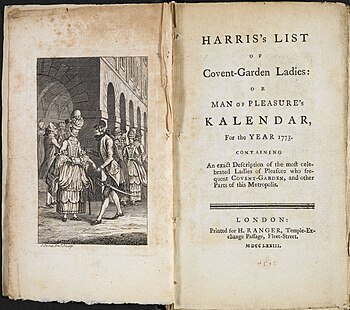
Frontispiece and title page of 1773 edition
Harris's List of Covent Garden Ladies, published from 1760 to 1794, was an annual directory of prostitutes then working in Georgian London. A small pocketbook, it was printed and published in Covent Garden, and sold for two shillings and sixpence. A contemporary report of 1791 estimates its circulation at about 8,000 copies annually.
Each edition contains entries describing the physical appearance and sexual specialities of about 120–190 prostitutes who worked in and around Covent Garden. Through their erotic prose, the list's entries review some of these women in lurid detail. While most compliment their subjects, some are critical of bad habits, and a few women are even treated as pariahs, perhaps having fallen out of favour with the list's authors, who are never revealed. (Full article...) -

Wordless novels flourished in Germany in the 1920s and typically were made using woodcut or similar techniques in an Expressionist style. (Frans Masereel, 25 Images of a Man's Passion, 1918)
The wordless novel is a narrative genre that uses sequences of captionless pictures to tell a story. As artists have often made such books using woodcut and other relief printing techniques, the terms woodcut novel or novel in woodcuts are also used. The genre flourished primarily in the 1920s and 1930s and was most popular in Germany.
The wordless novel has its origin in the German Expressionist movement of the early 20th century. The typically socialist work drew inspiration from medieval woodcuts and used the awkward look of that medium to express angst and frustration at social injustice. The first such book was the Belgian Frans Masereel's 25 Images of a Man's Passion, published in 1918. The German Otto Nückel and other artists followed Masereel's example. Lynd Ward brought the genre to the United States in 1929 when he produced Gods' Man, which inspired other American wordless novels and a parody in 1930 by cartoonist Milt Gross with He Done Her Wrong. Following an early-1930s peak in production and popularity, the genre waned in the face of competition from sound films and anti-socialist censorship in Nazi Germany and the US. (Full article...) -
Lemurs of Madagascar is a 2010 reference work and field guide for the lemurs of Madagascar, giving descriptions and biogeographic data for the known species. The primary contributor is Russell Mittermeier, president of Conservation International, and the cover art and illustrations were drawn by Stephen D. Nash. Currently in its third edition, the book provides details about all known lemur species, general information about lemurs and their history, and also helps travelers identify species they may encounter. Four related pocket field guides have also been released, containing color illustrations of each species, miniature range maps, and species checklists.
The first edition was reviewed favorably in the International Journal of Primatology, Conservation Biology, and Lemur News. Reviewers, including Alison Jolly, praised the book for its meticulous coverage of each species, numerous high-quality illustrations, and engaging discussion of lemur topics, including conservation, evolution, and the recently extinct subfossil lemurs. Each agreed that the book was an excellent resource for a wide audience, including ecotourists and lemur researchers. A lengthy review of the second edition was published in the American Journal of Primatology, where it received similar favorable comments, plus praise for its updates and enhancements. The third edition was reviewed favorably in Lemur News; the reviewer praised the expanded content of the book, but was concerned that the edition was not as portable as its predecessors. (Full article...) -
Fuck: Word Taboo and Protecting Our First Amendment Liberties is a nonfiction book by law professor Christopher M. Fairman about freedom of speech, the First Amendment to the United States Constitution, censorship, and use of the word fuck in society. The book was first published in 2009 by Sphinx as a follow-up on the author's article "Fuck", published in 2007 in the Cardozo Law Review. It cites studies from academics in social science, psychoanalysis, and linguistics. Fairman establishes that most current usages of the word have connotations distinct from its meaning of sexual intercourse. The book discusses the efforts of conservatives in the United States to censor the word from common parlance. The author says that legal precedent regarding its use is unclear because of contradictory court decisions. Fairman argues that once citizens allow the government to restrict the use of specific words, this will infringe upon freedom of thought.
The book received a mostly favorable reception from news sources and library trade publications. Library Journal described the book as a sincere analysis of the word and its history of censorship, Choice: Current Reviews for Academic Libraries called it stimulating, and the San Diego Law Review said it was thought-provoking. One reviewer said that the book, like the article, was a format for the author to repeatedly use "fuck" rather than analyze it from a rigorous perspective. After the book's release, Fairman was consulted by media sources including CNN and The New York Times, as well as the American Civil Liberties Union, on issues surrounding word taboo in society. (Full article...) -
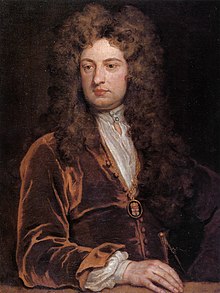
John Vanbrugh (1664–1726), author of The Relapse, by Godfrey Kneller
The Relapse, or, Virtue in Danger is a Restoration comedy from 1696 written by John Vanbrugh. The play is a sequel to Colley Cibber's Love's Last Shift, or, The Fool in Fashion.
In Cibber's Love's Last Shift, a free-living Restoration rake is brought to repentance and reform by the ruses of his wife, while in The Relapse, the rake succumbs again to temptation and has a new love affair. His virtuous wife is also subjected to a determined seduction attempt, and resists with difficulty. (Full article...) -
The Bread-Winners: A Social Study is an 1883 novel by John Hay, former secretary to Abraham Lincoln who in 1898 became U.S. Secretary of State. The book takes an anti-organized labor stance, and when published anonymously sold well and provoked considerable public interest in determining who the author was.
The plot of the book revolves around former army captain Arthur Farnham, a wealthy resident of Buffland (an analog of Cleveland). He organizes Civil War veterans to keep the peace when the Bread-winners, a group of lazy and malcontented workers, call a violent general strike. He is sought in marriage by the ambitious Maud Matchin, daughter of a carpenter, but instead weds a woman of his own class. (Full article...) -
The Halo Graphic Novel is a graphic novel anthology of the military science fiction video game series Halo, published by Marvel Comics in partnership with Bungie. The Halo Graphic Novel was the series' first entry into the sequential art medium, and features aspects of the Halo universe which until then had not been discussed or seen in any medium.
The majority of the book is divided into four short stories by different writers and artists from the computer game and comic industries. Each story focuses on different aspects of the Halo universe, revealing stories that are tangential to the main plot of the game. Apart from the stories, the book also contains an extensive art gallery compiled of contributions from Bungie, Marvel and independent sources. (Full article...) -
The General in His Labyrinth (original Spanish title: El general en su laberinto) is a 1989 dictator novel by Colombian writer and Nobel laureate Gabriel García Márquez. It is a fictionalized account of the last seven months of Simón Bolívar, liberator and leader of Gran Colombia. The book traces Bolívar's final journey from Bogotá to the Caribbean coastline of Colombia in his attempt to leave South America for exile in Europe. Breaking with the traditional heroic portrayal of Bolívar El Libertador, García Márquez depicts a pathetic protagonist, a prematurely aged man who is physically ill and mentally exhausted. The story explores the labyrinth of Bolívar's life through the narrative of his memories, in which "despair, sickness, and death inevitably win out over love, health, and life".
Following the success of One Hundred Years of Solitude (1967) and Love in the Time of Cholera (1985), García Márquez decided to write about the "Great Liberator" after reading an unfinished novel by his friend Álvaro Mutis. He borrowed the setting—Bolívar's voyage down the Magdalena River in 1830—from Mutis. García Márquez spent two years researching the subject, encompassing the extensive memoirs of Bolívar's Irish aide-de-camp, Daniel Florencio O'Leary, as well as numerous other historical documents and consultations with academics. (Full article...) -

Title page from the first edition of Locke's Some Thoughts Concerning Education (1693)
Some Thoughts Concerning Education is a 1693 treatise on the education of gentlemen written by the English philosopher John Locke. For over a century, it was the most important philosophical work on education in England. It was translated into almost all of the major written European languages during the eighteenth century, and nearly every European writer on education after Locke, including Jean-Jacques Rousseau, acknowledged its influence.
In his Essay Concerning Human Understanding (1690), Locke outlined a new theory of mind, contending that the mind is originally a tabula rasa or "blank slate"; that is, it did not contain any innate ideas at birth. Some Thoughts Concerning Education explains how to educate that mind using three distinct methods: the development of a healthy body; the formation of a virtuous character; and the choice of an appropriate academic curriculum. (Full article...) -
Jack the Ripper: The Final Solution is a book written by Stephen Knight first published in 1976. It proposed a solution to five murders in Victorian London that were blamed on an unidentified serial killer known as "Jack the Ripper".
Knight presented an elaborate conspiracy theory involving the British royal family, freemasonry and the painter Walter Sickert. He concluded that the victims were murdered to cover up a secret marriage between the second-in-line to the throne, Prince Albert Victor, Duke of Clarence and Avondale, and Annie Elizabeth Crook, a working class girl. There are many facts that contradict Knight's theory, and his main source, Joseph Gorman (also known as Joseph Sickert), later retracted the story and admitted to the press that it was a hoax. (Full article...) -
Ravenloft is an adventure module for the Dungeons & Dragons (D&D) fantasy role-playing game. The American game publishing company TSR, Inc. released it as a standalone adventure booklet in 1983 for use with the first edition Advanced Dungeons & Dragons game. It was written by Tracy and Laura Hickman, and includes art by Clyde Caldwell with maps by David Sutherland III. The plot of Ravenloft focuses on the villain Strahd von Zarovich, a vampire who pines for his lost love. Various story elements, including Strahd's motivation and the locations of magical weapons, are randomly determined by drawing cards. The player characters attempt to defeat Strahd and, if successful, the adventure ends.
The Hickmans began work on Ravenloft in the late 1970s, intent on creating a frightening portrait of a vampire in a setting that combined Gothic horror with the D&D game system. They play-tested the adventure with a group of players each Halloween for five years before it was published. Strahd has since appeared in a number of D&D accessories and novels. The module has inspired numerous revisions and adaptations, including a campaign setting of the same name and a sequel. In 1999, on the 25th anniversary of Dungeons & Dragons, two commemorative versions of Ravenloft were released. (Full article...) -
Boenga Roos dari Tjikembang ([buˈŋa ˈrus daˈri tʃiˈkəmbaŋ]; translated to English as The Rose of Cikembang) is a 1927 vernacular Malay-language novel written by Kwee Tek Hoay. The seventeen-chapter book follows a plantation manager, Aij Tjeng, who must leave his beloved njai (concubine) Marsiti so that he can be married. Eighteen years later, after Aij Tjeng's daughter Lily dies, her fiancé Bian Koen discovers that Marsiti had a daughter with Aij Tjeng, Roosminah, who greatly resembles Lily. In the end Bian Koen and Roosminah are married.
Inspired by the lyrics to the song "If Those Lips Could Only Speak" and William Shakespeare's A Midsummer Night's Dream, Boenga Roos dari Tjikembang was initially written as an outline for the stage drama troupe Union Dalia. Kwee intermixed several languages other than Malay, particularly Dutch, Sundanese, and English; he included two quotes from English poems and another from an English song. The novel has been interpreted variously as a promotion of theosophy, a treatise on the Buddhist concept of reincarnation, a call for education, an ode to njais, and a condemnation of how such women are treated. (Full article...) -
Race Against Time: Searching for Hope in AIDS-Ravaged Africa is a non-fiction book written by Stephen Lewis for the Massey Lectures. Lewis wrote it in early to mid-2005 and House of Anansi Press released it as a corresponding lecture series began in October 2005. Each of the book's chapters were delivered as a different lecture in a different Canadian city, beginning in Vancouver on October 18 and ending in Toronto on October 28. The speeches were aired on CBC Radio One between November 7 and 11. The author and orator, Stephen Lewis, was at that time the United Nations Special Envoy for HIV/AIDS in Africa and former Canadian ambassador to the United Nations. Although he wrote the book and lectures in his role as a concerned Canadian citizen, his criticism of the United Nations (UN), international organizations, and other diplomats, including naming specific people, was called undiplomatic and led several reviewers to speculate whether he would be removed from his UN position.
In the book and the lectures, Lewis argues that significant changes are required to meet the Millennium Development Goals in Africa by their 2015 deadline. Lewis explains the historical context of Africa since the 1980s, citing a succession of disastrous economic policies by international financial institutions that contributed to, rather than reduced, poverty. He connects the structural adjustment loans, with conditions of limited public spending on health and education infrastructure, to the uncontrolled spread of AIDS and subsequent food shortages as the disease infected much of the working-age population. Lewis also addresses such issues as discrimination against women and primary education for children. To help alleviate problems, he ends with potential solutions which mainly require increased funding by G8 countries to levels beyond what they promise. (Full article...)
Selected picture

Credit: Diliff
More Did you know (auto generated)

- ... that the 2018 book The Longevity Diet claims that a "fast-mimicking diet" increases lifespan and healthspan?
- ... that Steve Englehart wrote the Captain America comic book storyline "Secret Empire" as an allegory for the Watergate scandal?
- ... that the short story collection Drinking Coffee Elsewhere was chosen by John Updike as a selection for the Today Show book club on NBC?
- ... that the 1923 book Motion Pictures in Education is among the first major works about using films to teach students?
- ... that when Maria Keller was eight years old, she founded a nonprofit that would later go on to collect and distribute more than three million books to underprivileged children?
- ... that the Chronicle of the 20th Century was so heavy that it was said to be "the first coffee table book seriously to threaten the well-being of coffee-tables"?
Books topics
Related portals
-
The War Within: A Secret White House History (2006–2008) is a non-fiction book by Washington Post reporter Bob Woodward that was released by publisher Simon & Schuster on September 8, 2008. It is the fifteenth book written by Woodward, the fourth in a series of books about President George W. Bush and his administration's foreign policy including Bush at War, Plan of Attack, and State of Denial. The book discusses the debate within the administration about the controversial Iraq "surge" strategy implemented in 2007. Simon & Schuster editor Alice Mayhew said in an official statement that "There has not been such an authoritative and intimate account of presidential decision making since the Nixon tapes and the Pentagon Papers. This is the declassification of what went on in secret, behind the scenes." (Full article...) -
John Joscelyn, also John Jocelyn or John Joscelin, (1529–1603) was an English clergyman and antiquarian as well as secretary to Matthew Parker, an Archbishop of Canterbury during the reign of Queen Elizabeth I of England. Joscelyn was involved in Parker's attempts to secure and publish medieval manuscripts on church history, and was one of the first scholars of the Old English (Anglo-Saxon) language. He also studied the early law codes of England. His Old English dictionary, although not published during his lifetime, contributed greatly to the study of that language. Many of his manuscripts and papers eventually became part of the collections of Cambridge University, Oxford University, or the British Library. (Full article...) -
Spain in Our Hearts: Americans in the Spanish Civil War, 1936–1939 is a non-fiction book by Adam Hochschild that was first published by Houghton Mifflin Harcourt on March 29, 2016. The book is an account of the American volunteers who participated in the Spanish Civil War from 1936 to 1939. The story centers around several American volunteer fighters and journalists, tracing their motivations for joining the war and their experiences during the war which left many disillusioned. The book explains the involvement of foreign leaders including Adolf Hitler, Benito Mussolini and Joseph Stalin, and explains why the Republican faction ultimately lost.
Hochschild knew several American volunteers personally, and was partly inspired by them to write the book. Most of Hochschild's archival research on the subject was carried out at the Tamiment Library and Robert F. Wagner Archives. (Full article...) -
Occupy is a short study of the Occupy movement written by the American academic and political activist Noam Chomsky. Initially published in the United States by the Zuccotti Park Press as the first title in their Occupied Media Pamphlet Series in 2012, it was subsequently republished in the United Kingdom by Penguin Books later that year.
An academic linguist at the Massachusetts Institute of Technology, Chomsky first achieved fame for his work as a political activist during the 1960s and 1970s. A libertarian socialist, Chomsky is a prominent critic of capitalism, the role of western media and the foreign policy of the U.S. government, dealing with such issues in bestsellers like Manufacturing Consent (1988), Hegemony or Survival (2003) and Failed States (2006). With the birth of the Occupy Movement – devoted to socio-political change – in 2011, Chomsky became a vocal supporter for the protesters, writing articles and giving speeches on their behalf, several of which were collected together and published as Occupy. (Full article...) -
Syntactic Structures is an important work in linguistics by American linguist Noam Chomsky, originally published in 1957. A short monograph of about a hundred pages, it is recognized as one of the most significant and influential linguistic studies of the 20th century. It contains the now-famous sentence "Colorless green ideas sleep furiously", which Chomsky offered as an example of a grammatically correct sentence that has no discernible meaning, thus arguing for the independence of syntax (the study of sentence structures) from semantics (the study of meaning).
Based on lecture notes he had prepared for his students at the Massachusetts Institute of Technology in the mid-1950s, Syntactic Structures was Chomsky's first book on linguistics and reflected the contemporary developments in early generative grammar. In it, Chomsky introduced his idea of a transformational generative grammar, succinctly synthesizing and integrating the concepts of transformation (pioneered by his mentor Zellig Harris, but used in a precise and integrative way by Chomsky), morphophonemic rules (introduced by Leonard Bloomfield) and an item-and-process style of grammar description (developed by Charles Hockett). Here, Chomsky's approach to syntax is fully formal (based on symbols and rules). At its base, Chomsky uses phrase structure rules, which break down sentences into smaller parts. These are combined with a new kind of rules which Chomsky called "transformations". This procedure gives rise to different sentence structures. Chomsky stated that this limited set of rules "generates" all and only the grammatical sentences of a given language, which are infinite in number (not too dissimilar to a notion introduced earlier by Danish linguist Louis Hjelmslev). Although not explicitly stated in the book itself, this way of study was later interpreted to have valued language's innate place in the mind over language as learned behavior, (Full article...) -
The Lost Caverns of Tsojcanth is an adventure module for the Dungeons & Dragons fantasy role-playing game. It was written by Gary Gygax and published by TSR in 1982 for the first edition Advanced Dungeons & Dragons (AD&D) rules. The 64-page adventure bears the code "S4" ("S" for "special") and is set in the Greyhawk campaign setting. It is divided into two parts, a 32-page adventure, and a 32-page booklet of monsters and magic items. The plot involves the player characters investigating rumors of lost treasure. After traversing a wilderness and two levels of dungeons, the players face Drelnza, the vampiric daughter of long-deceased archmage Iggwilv.
The Lost Caverns of Tsojcanth is a revised and expanded version of The Lost Caverns of Tsojconth, a tournament adventure that Gygax wrote for the 1976 WinterCon V gaming convention. Gygax expanded the tournament adventure by adding a wilderness area, with part of it based on earlier work by Rob Kuntz. Work on the adventure delayed the completion of The Temple of Elemental Evil, another Gygax adventure. The Lost Caverns of Tsojcanth was included in the 1987 supermodule Realms of Horror, and updated for v3.5 in an online edition in 2007. It was well received by critics, ranked the 22nd greatest Dungeons & Dragons adventure of all time by Dungeon magazine in 2004. A White Dwarf reviewer gave the adventure 9/10, noting its difficulty and rewards of powerful magic. It is part of a series along with S1: Tomb of Horrors, S2: White Plume Mountain, S3: Expedition to the Barrier Peaks. It also has a loosely connected sequel: The Forgotten Temple of Tharizdun. (Full article...) -
The Utility of Force: The Art of War in the Modern World is a treatise on modern warfare written by General Sir Rupert Smith and published in 2005. Smith is a retired general who spent 40 years in the British Army; he commanded the 1st Armoured Division in the First Gulf War and served as General Officer Commanding Northern Ireland at the end of the Troubles. He was motivated to write the book by his experiences in the Balkans. He commanded the United Nations Protection Force (UNPROFOR) in Bosnia from 1995 to 1996, during which time the Srebrenica massacre occurred and the capital, Sarajevo, was under siege by Serb forces. Smith was instrumental in the lifting of the siege by arranging for NATO air strikes and an artillery barrage. This enabled a ground assault by Bosnian and Croatian forces that ended the siege and led to the Dayton Agreement. Smith's second involvement with the Balkans was in 1999 during the Kosovo War, when he was serving as NATO's Deputy Supreme Allied Commander Europe, overseeing air strikes against Serb targets.
Smith's thesis, and the central theme of The Utility of Force, is that the world entered a new paradigm of conflict at the end of the 20th and beginning of the 21st centuries, which he calls "war amongst the people", and that Western, industrialised armies are ill-suited to the new style of warfare. The defining characteristics of "war amongst the people" are that conflicts tend to be timeless, more political in nature, and fought between parties that are part of, and in amongst, the civilian population rather than between uniformed armies on a battlefield. To prove his theory, Smith provides a detailed history starting with Napoleon, who invented what Smith calls "industrial warfare"—the paradigm in which the entire resources of the nation were mustered and which culminated in the two world wars. In the second half of the book, Smith states that the advent of nuclear weapons rendered industrial warfare obsolete, but that Western governments and generals refused to acknowledge the new paradigm, which led to several significant defeats in the second half of the 20th century. He provides six themes which characterise modern conflicts and proceeds to analyse each in detail, before dedicating his final chapter to his reflections on his command in Bosnia. He concedes that he did not foresee the Srebrenica massacre, but criticises UNPROFOR, believing that it was not in a position to act even had the massacre been foreseen and that it had no strategy for effectively intervening in the war. In his conclusion, Smith argues that military force is only part of the solution in modern conflicts, and that it must be combined with political initiatives which together will subdue but not necessarily end the conflict. (Full article...) -
Street Gang: The Complete History of Sesame Street is a non-fiction book chronicling the history of the children's television program Sesame Street. Street Gang is journalist and writer Michael Davis's first book, published by Viking Press in 2008. On bookshelves in time for the show's 40th anniversary in 2009, the book developed out of a TV Guide article Davis wrote to commemorate the show's 35th anniversary in 2004. Davis spent five years researching and writing the book, and conducted hundreds of interviews with the show's creators, cast, and crew.
Street Gang begins with a description of Muppet creator Jim Henson's 1990 funeral, from the perspective of co-creator Joan Ganz Cooney. Its first twelve chapters describe the origin, development, and early years of Sesame Street and the Children's Television Workshop, the organization created to oversee the production of the show and other projects. Davis includes the biographies of many of the key people involved with the creation and production of Sesame Street. Subsequent chapters chronicle the rest of the show's history, up to its 40th anniversary in 2009. (Full article...) -
Yakov and the Seven Thieves is a picture book written by American entertainer Madonna. It was released on June 21, 2004, by Callaway Arts & Entertainment in over 110 countries and 38 different languages, including a Braille edition. The book contains a moral tale and was inspired by a 300-year-old story by rabbi Baal Shem Tov, that Madonna had heard from her Kabbalah teacher. The premise was set in a small, 18th century town in Eastern Europe, and the story talks about how everyone has the ability to open the gates of heaven, however unworthy one is deemed to be.
The cover art and the images inside were painted by Russian illustrator Gennady Spirin who chose Baroque painting as inspiration for crafting the characters and the scenery. Like her previous endeavors, Madonna promoted the release by appearing on talk show and reading to children at a hospital in London. Critics gave mixed review of the book, with reviews being mostly negative about Madonna's writing but praised Spirin's illustrations. Three weeks after its release, Yakov and the Seven Thieves debuted at number seven on The New York Times Best Seller list in the category for Children's Picture books. (Full article...) -
Man After Man: An Anthropology of the Future is a 1990 speculative evolution and science fiction book written by Scottish geologist and palaeontologist Dougal Dixon and illustrated by Philip Hood. The book also features a foreword by Brian Aldiss. Man After Man explores a hypothetical future path of human evolution set from 200 years in the future to 5 million years in the future, with several future human species evolving through genetic engineering and natural means through the course of the book.
Man After Man is Dixon's third work on speculative evolution, following After Man (1981) and The New Dinosaurs (1988). Unlike the previous two books, which were written much like field guides, the focus of Man After Man lies much on the individual perspectives of future human individuals of various species. Man After Man, like its predecessors, uses its fictional setting to explore and explain real natural processes, in this case climate change through the eyes of the various human descendants in the book, who have been engineered specifically to adapt to it. (Full article...) -
Power: A New Social Analysis by Bertrand Russell (1st imp. London 1938, Allen & Unwin, 328 pp.) is a work in social philosophy written by Bertrand Russell. Power, for Russell, is one's ability to achieve goals. In particular, Russell has in mind social power, that is, power over people.
The volume contains a number of arguments. However, four themes have a central role in the overall work. The first theme given treatment in the analysis is that the lust for power is a part of human nature. Second, the work emphasises that there are different forms of social power, and that these forms are substantially interrelated. Third, Power insists that "organisations are usually connected with certain kinds of individuals". Finally, the work ends by arguing that "arbitrary rulership can and should be subdued". (Full article...) -
Modern Cookery for Private Families is an English cookery book by Eliza Acton. It was first published by Longmans in 1845, and was a best-seller, running through 13 editions by 1853, though its sales were later overtaken by Mrs Beeton. On the strength of the book, Delia Smith called Acton "the best writer of recipes in the English language", while Elizabeth David wondered why "this peerless writer" had been eclipsed by such inferior and inexperienced imitators.
It was one of the first cookery books to provide lists of ingredients, exact quantities, and cooking times, and to include Eastern recipes for chutneys. (Full article...) -
Van Morrison: Too Late to Stop Now is a biography of musician Van Morrison, written by Steve Turner. It was first published in 1993 in the United States by Penguin Group, and in Great Britain by Bloomsbury Publishing. Turner first met Van Morrison in 1985; he interviewed approximately 40 people that knew the subject in his research for the biography. Van Morrison did not think positively of the biography, and multiple newspapers reported he attempted to purchase all of the book's 25,000 copies. He sent a letter to the author asserting the 40 individuals interviewed for the book were not his friends, and accused Turner of "peddling distortions and inaccuracies about me personally".
The biography takes a pictorial format, and includes many photographs of Van Morrison and scenes relating to his life, including close-up shots and contact prints. Turner discusses Van Morrison's youth in Belfast, Northern Ireland, and how early experiences shaped his perceptions. Flautist John Payne was interviewed for the book, and comments on his work with Van Morrison on the album Astral Weeks. Turner discusses Van Morrison's reluctance to be interviewed or engage with the public, and includes quotes from the musician about this desire for privacy. The author discusses Van Morrison's efforts to seek out creativity, and his exploration of spirituality. The book concludes with an assessment of Van Morrison's experiences with religion. (Full article...) -
Fences and Windows: Dispatches from the Front Lines of the Globalization Debate is a 2002 book by Canadian journalist Naomi Klein and editor Debra Ann Levy. The book is a collection of newspaper articles, mostly from The Globe and Mail, with a few magazine articles from The Nation and speech transcripts. The articles and speeches were all written by Klein in the 30 months after the publication of her first book, No Logo (1999), from December 1999 to March 2002. The articles focus upon the anti-globalization movement, including protest events and responses by law enforcement. The book was published in North America and the United Kingdom in October 2002.
The imagery of fences and windows appear throughout the work. The fences represent exclusion and barriers, while the windows are opportunities for expressing alternative ideas. The book garnered both positive and negative reviews. Two of the articles were singled out as exceptional by several reviewers: "America is not a Hamburger" discusses the US State Department's attempt to re-brand America's image overseas; "The Brutal Calculus of Suffering" discusses media portrayals of war. (Full article...) -
Yoga Makaranda (Sanskrit: योग मकरन्द), meaning "Essence of Yoga", is a 1934 book on hatha yoga by the influential pioneer of yoga as exercise, Tirumalai Krishnamacharya. Most of the text is a description of 42 asanas accompanied by 95 photographs of Krishnamacharya and his students executing the poses. There is a brief account of practices other than asanas, which form just one of the eight limbs of classical yoga, that Krishnamacharya "did not instruct his students to practice".
The yoga scholar Mark Singleton notes that the book is almost legendary among Pattabhi Jois's students, though "very few have actually seen it". Singleton notes, too, that the book was "experimental". The yoga scholar Norman Sjoman criticises the book's "padded academic bibliography" full of irrelevant works, and the perfunctory and ill-informed coverage of yoga practices other than asanas, while another yoga scholar, Elliott Goldberg, comments that the photographs serve to demystify the asanas of their spiritual content, and that Krishnamacharya was falsely claiming an ancient origin for his dynamic vinyasa system of yoga. (Full article...)
Selected quote
| “ | A single book at the right time can change our views dramatically, give a quantum boost to our knowledge, help us construct a whole new outlook on the world and our life. Isn't it odd that we don't seek those experiences more systematically? | ” |
| — Steve Leveen | ||
Did you know
- ...that the Arabic translation of Borunsi sold one million copies in its first year of publication?
- ...that Albert Pick wrote the first modern catalog of banknotes in 1974 ?
General images
-
Modern book spine designs (from Bookbinding)
-
Hardbound book spine stitching (from Bookbinding)
-
Dresden Codex (page 49) (from History of books)
-
Book conservators at the State Library of New South Wales, 1943 (from Bookbinding)
-
Traditionally sewn book opened flat (from Bookbinding)
-
European output of manuscripts 500–1500 (from History of books)
-
Early medieval bookcase containing about ten codices depicted in the Codex Amiatinus (c. 700) (from Bookbinding)
-
The spine of the book is an important aspect in book design, especially in the cover design. When the books are stacked up or stored in a shelf, the details on the spine is the only visible surface that contains the information about the book. In a book store, it is often the details on the spine that attract the attention first. (from Book design)
-
European output of books 500–1800 (from History of books)
-
Rebacking saving original spine, showing one volume finished and one untouched (from Bookbinding)
-
9th-century Qur'an in Reza Abbasi Museum (from Bookbinding)
-
The Codex Manesse, a German book from the Middle Ages (from History of books)
-
Jikji, Selected Teachings of Buddhist Sages and Seon Masters, the earliest known book printed with movable metal type, 1377. Bibliothèque Nationale de France, Paris. (from History of books)
-
Scheme of common book design(from Bookbinding)
- Belly band
- Flap
- Endpaper
- Book cover
- Head
- Fore edge
- Tail
- Right page, recto
- Left page, verso
- Gutter
-
The Book of the Dead of Hunefer, c. 1275 BCE, ink and pigments on papyrus, in the British Museum (London) (from History of books)
-
An author portrait of Jean Miélot writing his compilation of the Miracles of Our Lady, one of his many popular works. (from History of books)
-
European output of printed books c. 1450–1800 (from History of books)
-
Example of blind tooling a book binding with exquisite detail (from Bookbinding)
-
Design by Hans Holbein the Younger for a metalwork book cover (or treasure binding) (from Book design)
-
12-metre-high (40 ft) stack of books sculpture at the Berlin Walk of Ideas, commemorating the invention of modern book printing (from History of books)
-
Decorative binding with figurehead of the 12th century manuscript Liber Landavensis (from Bookbinding)
-
Bookbinder's type holder (from Bookbinding)
-
Three books with different titling orientations:
(left) ascending
(middle) descending
(right) upright (from Bookbinding) -
Photograph of a printing press in Egypt, c. 1922 (from History of books)
-
Woman holding wax tablets in the form of the codex. Wall painting from Pompeii, before 79 CE. (from History of books)
-
A traditional bookbinder at work (from Bookbinding)
-
Folio from the Shah Jahan Album, c. 1620, depicting the Mughal Emperor Shah Jahan (from History of books)
-
Page from the Blue Quran manuscript, ca. 9th or 10th century CE (from History of books)
-
Modern paperback spines (from Bookbinding)
-
A Chinese bamboo book (from History of books)
-
Cloth book cover with attached paper panel, mimicking half leather binding (from Bookbinding)
-
Hardbound book with half leather binding (spine and corners) and marbled boards (from Bookbinding)
-
Sammelband of three alchemical treatises, bound in Strasbourg by Samuel Emmel c. 1568, showing metal clasps and leather covering of boards (from Bookbinding)
-
A Sumerian clay tablet, currently housed in the Oriental Institute at the University of Chicago, inscribed with the text of the poem Inanna and Ebih by the priestess Enheduanna, the first author whose name is known
-
Page from a Jain manuscript depicting the birth of Mahavira, c. 1400 (from History of books)
-
The scene in Botticelli's Madonna of the Book (1480) reflects the presence of books in the houses of richer people in his time. (from History of books)
-
Page spread with J. A. van de Graaf's construction of classical text area (print space) and margin proportions (from Book design)
-
A 15th-century Incunable. Notice the blind-tooled cover, corner bosses, and clasps. (from History of books)
-
Folio from a manuscript of the Shanamah (Book of Kings) (from History of books)
-
Marbled book board from a book published in London in 1872 (from Bookbinding)
Books lists
WikiProjects
Categories
Things you can do

- Find news articles regarding notable books and add them to the "In the news" section.
- Expand this portal and book-related articles: List of Jamaican books
- Create new articles: Lists of books provides a comprehensive list of notable books, many of which have no articles.
- Add references: List of CEO books, List of anonymously published works
- Make this portal more complete:
- Add {{WPBooks}} to the Talk pages of articles about notable books – but try to add an initial Assessment from the Wikipedia:WikiProject_Books
- Add
{{Portal|Books}}to appropriate articles within the subject
- Anything else you can think of doing.
Web resources
- Bookbinding and the Conservation of books, A Dictionary of Descriptive Terminology, 1982 by Matt T. Roberts and Don Etherington
- IOBA glossary of book terms
- Project Gutenberg - Free e-Books
- Words at Large: The best in books from CBC.ca
- please add more!
Associated Wikimedia
The following Wikimedia Foundation sister projects provide more on this subject:
-
Commons
Free media repository -
Wikibooks
Free textbooks and manuals -
Wikidata
Free knowledge base -
Wikinews
Free-content news -
Wikiquote
Collection of quotations -
Wikisource
Free-content library -
Wikispecies
Directory of species -
Wikiversity
Free learning tools -
Wikivoyage
Free travel guide -
Wiktionary
Dictionary and thesaurus







